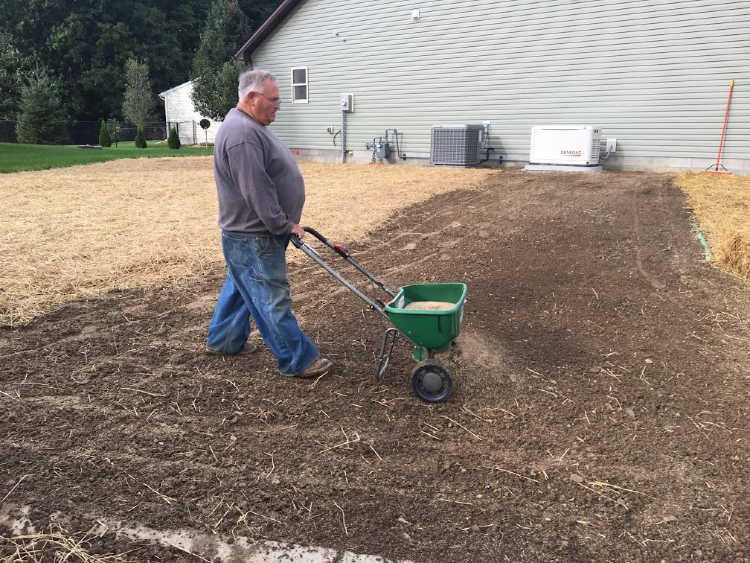
Preparing a new lawn for grass seed is a bit of work, but it’s not that difficult to do successfully if you are armed with just a bit of basic information.
A few basics that you must get right…
- The area has to be properly graded before you start.
- It’s best if you have a few lawn installation tools to make the job easier.
- You use a good blend of grass seed.
- You pay close attention to what cover you use and why.
Pam and I recently built a new house, you know, all one floor, no steps.
I tell people that we built a convalescent home.
Wide hallways, grab bars in the bathroom.
The lot that we chose to build on is quite small, just enough room for the house really.
And a little bit of lawn.
We needed something easy to care for, we have plenty to do at Mike’s Plant Farm.
And the new place is only about 2 minutes from the nursery which is really nice.
We hired contractors to do most of the construction but when it came the lawn and the landscape I just wasn’t going to pay that kind of money to do something I could do myself.
I have a tractor so I was able to do most of the final grading myself and with a 3 point hitch tiller on the back of the tractor I was able to loosen the hard packed soil around the house, level it, then we still needed to hand rake the entire area.
Topsoil?
I first started installing lawns back in 1974 and back in the day we never trucked in topsoil to make a lawn.
We quite simply worked with whatever soil was there. And it worked!
When you truck in a bunch of topsoil two things happen.
- You take a lot of money out of your wallet and give it to somebody else.
- You take soil that is riddled with more weed seed that you can imagine and move that to your house. How crazy is that?
- And really good topsoil is pretty hard to come by these days.
But these landscapers today just have it in their head that you can’t grow grass without topsoil.
I’m sorry, but I don’ just don’t subscribe to that theory.
I’ve installed lawns in some the most hard packed clay and rocky soil imaginable and I proud to say that I’ve produced some pretty darn nice lawns.
Many also believe that if you don’t hydro-seed, your new lawn doesn’t have a chance.
Nothing could be further from the truth and I Cover that in Detail Here.
Once you have the lawn area leveled or graded as needed so no water stands in the lawn area, you are ready to start preparing the soil for the planting of the grass seed.
In order to effectively plant grass seed you need to create at least a little bit of a seed bed.
Ideally proceed in this order;
- Loosen the soil to a depth of at least 3 to 4 four inches.
- Hand rake the entire lawn after you’ve loosen the soil.
- Apply a seed starting lawn fertilizer.
- Spread the grass seed over the raked area.
- Broom over the seed to mix it with the soil.
- Mulch over the seeded area with straw.
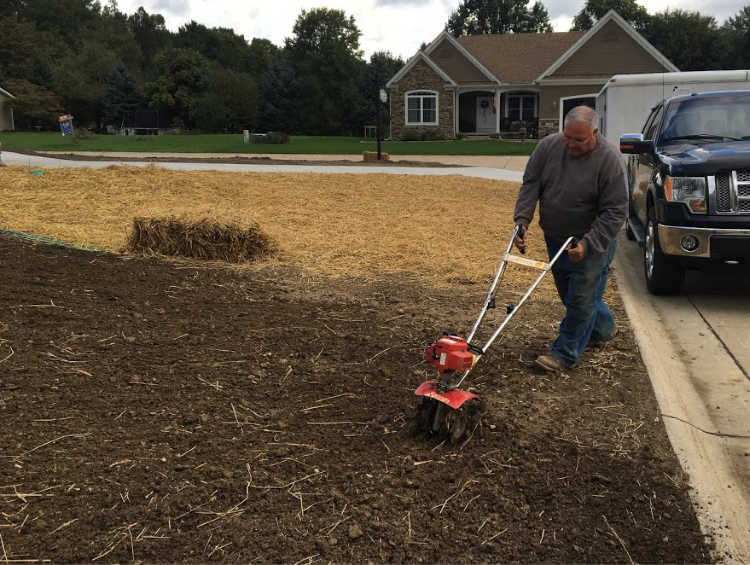
As I prepared our lawn for seeding I rototilled it to a depth or at least 4″ with the tiller on my tractor.
By loosening the soil that deep you accomplish a couple of things.
One, you allow the soil to absorb water when it rains or when you water, actually watering the seed into the lawn instead of the water just running off and taking the seed with it.
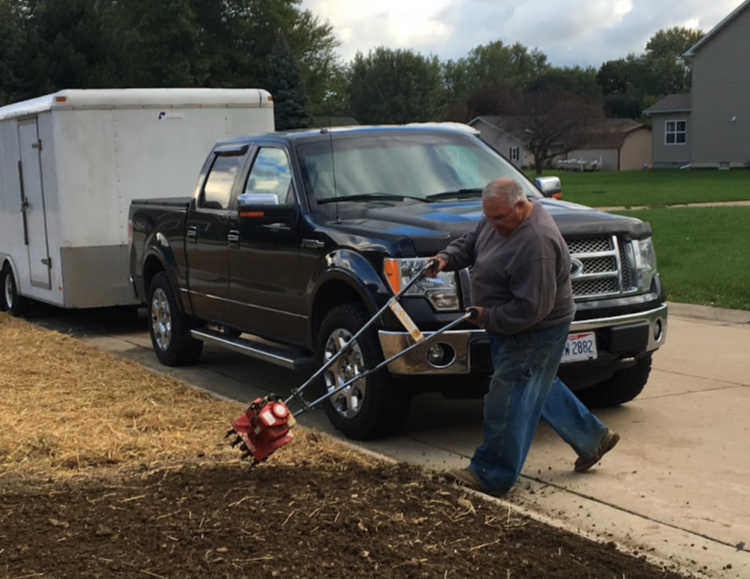
The second thing that you do by loosening the soil you make it much easier for the roots of the new grass plants to firmly anchor themselves in the soil to a reasonable depth.
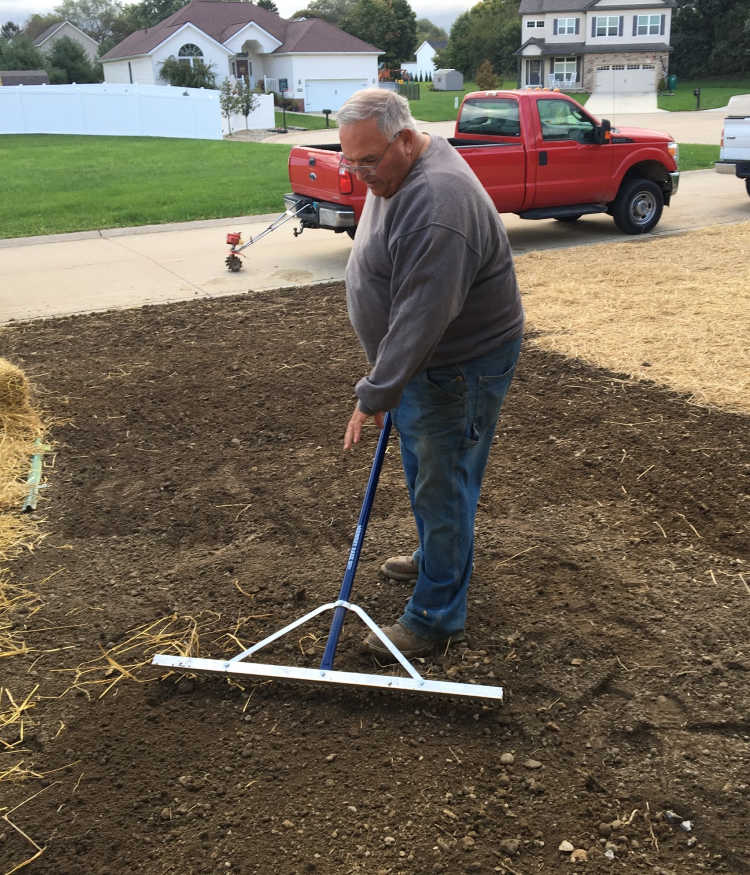
When you are doing a lawn by hand like Pam and did at our house it’s far better to tackle one area at a time and do all of the steps in that one area before moving on to another area.
Why? Because if you are doing this by hand without the help of three or four laborers, it’s going to take some time and once you have an area ready for seed you want to get it seeded, broomed and mulched before it gets rained on.
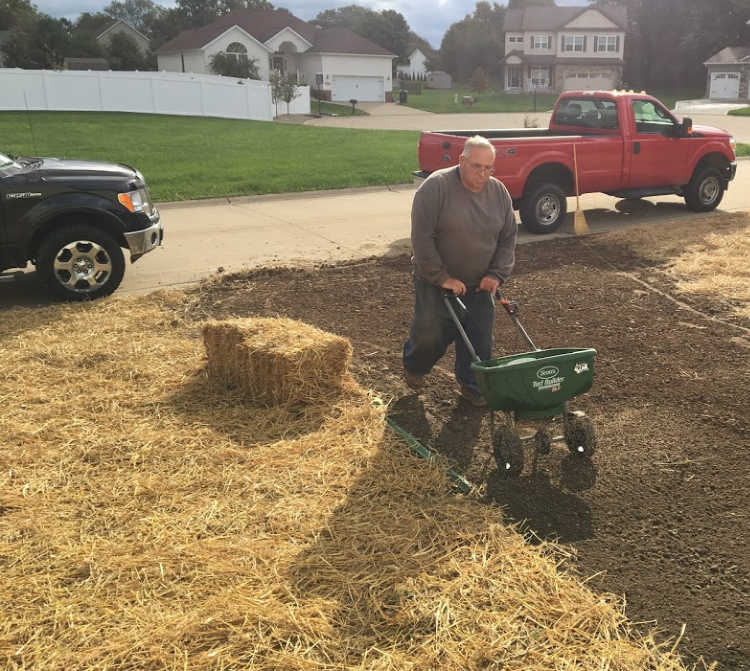
We did pretty well but we only got a third of our lawn done before we left on a week-long vacation that had been scheduled for many months.
And of course, it rained on the lawn.
That was good for the area that we had seeded, but not so good for the areas not yet done.
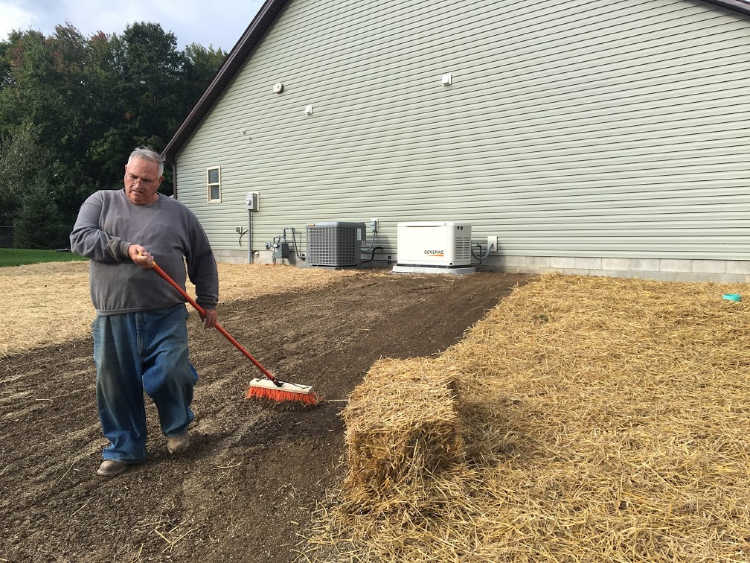
Because the soil was a bit sticky I didn’t want to get back on the lawn with my tractor and make ruts so I relied on my old faithful friend my Mantis Tiller!
I used the Mantis Tiller to loosen the soil and prepare a seed bed before raking the area level for seeding.
Please note!
Everything that you rake off of your lawn is not necessarily debris that needs to be disposed of.
In our case, I had a pretty big hole left where they put the water line in and the soil settled.
Everything that we raked up went into those low areas then got covered with soil.
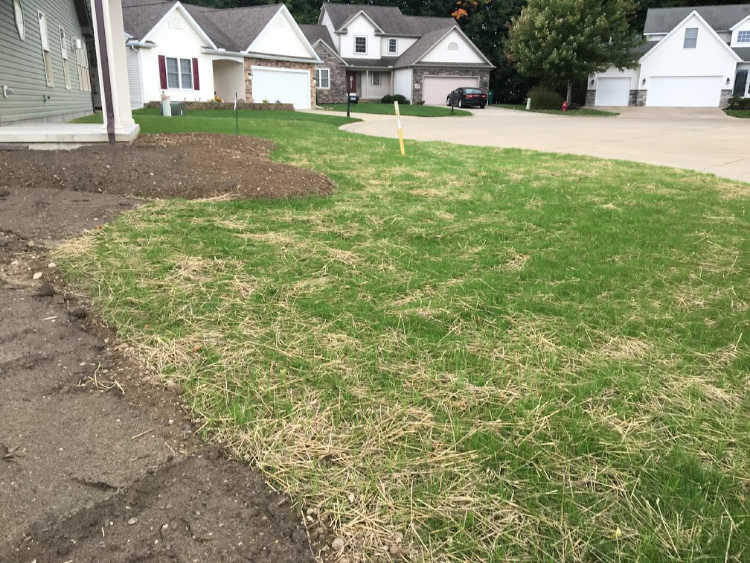
When we finished we only removed about 1/4 yard of debris from our lawn.
I’ve seen landscapers haul away tons and tons of soil and stuff when installing a lawn.
Once you prepare your seed bed and hand rake the area you can apply the grass seed starting fertilizer. Then start seeding.
Most grass seeds are applied at a rate of 5lbs per 1,000 square feet but look on the bag of seed or speak to your seed dealer for application rates.
Grass seed sizes can vary greatly thus the application rate can be less or more.
The best way to apply the grass seed is with a spreader so your get good even coverage, but I’ve probably spread hundreds of pounds of grass seed with my hand.
Once I spread the grass seed on the lawn I take a push broom and drag it backwards over the lawn area, applying some pressure to the broom.
I want the broom to drag some seed and soil as I do that.
This process actually helps to push the grass seed into the soil just enough so it’s not just laying on top of the soil and it buries some of the seed so it’s not just laying on top of the soil.
Once the seed is spread and broomed it’s time to mulch the seeded area.
My favorite mulch for planting grass seed is straw and I’ll tell you why.
When you spread mulch over the lawn the straw lands in a criss-cross pattern and doesn’t lay flat on the soil.
These suspended pieces of straw actually shade the grass seed!
Grass seeds are tiny so a piece of straw suspended overhead actually provides a considerable amount of shade as the sun moves over the lawn area.
When you mulch with peat moss or hydro mulch many of the seeds are exposed to the elements.
Straw actually provides great shade for those little tiny grass seeds and that shade can mean the difference between life and death for those new grass plants.
Keep in mind, it’s easy to get grass seed to germinate.
The challenge is keeping those little tiny plants alive until they can fatten up and send some roots down into the soil.
Once the seed germinates it is spent. If you lose the grass plants post germination your lawn is toast.
That’s why it’s so important to use a mulch that not only holds some moisture, but also provides shade for the grass seeds and tiny grass plants.
That’s also why it’s so important to stay on top of the watering once you initiate germination. Do Not Allow Your Lawn to Dry Out.
Questions, comments or mean things to say? Post them below and by any and all means, stay inspired.
I am planting in FULL sun in the hot desert southwest. What type of grass seed should I use and should I use the straw?
Kendra,
I’m the wrong person to ask, visit a privately owned garden center near you, not a box store.
I’ve done this in Northern California about 20 minutes away from death valley. Use extra straw, about a half inch thick. It’ll be worth it, tree extra straw will give a bit more drought resistance in the future as well. It’ll help everything establish. You can do it. I’ve done it in 113°F. Mulch is going to be your best friend.
till baby till! i started with a fresh seed bed. basically after 10+ years of weed growth ( i mowed the lawn, vs. cut the grass…hey it was green for most of the summer, lmao) i tore it all out. in that process, i did however, have 3 cu yards of topsoil dumped. it was basically a goodwill gesture for some the soil loss that came with pulling all the weeds out from the root. recommenced? maybe, maybe not. i paid $150 to have it delivered. other than that, i like your advice concerning adding the top layer of straw. one question i have though, if anyone would like to comment, is that i have VERY NICE 5hp MTD old school tiller. (circa 1988)…hey what can say, it’s been well maintained throughout the years by a since deceased family memeber. anyway, after dropping the seed into the newly prepared seed bed, would it be beneficial / harmful to go back over the newly dropped seed with the tiller, and i mean very lightly (i have an excellent sense of control using that piece of equipment)? thanks in advance!
Gene,
The answer is no. Tilling at all will plant the seed too deep. All I do after sowing the seed is to take a push broom and drag it backwards over the seeded area. This mixes the seed with the soil just enough to keep most of it away from birds and allows the soil to keep the seed moist longer after watering. Straw is a huge help. The reason I don’t like adding topsoil is because topsoil is loaded with weed seeds. I’ve put in beautiful lawns in nothing but clay and in yards so rocky we could barely rake them out. You really have to fertilize anyway so your grass gets nutrition that way. Today most landscapers truck in topsoil but that really runs up the price by thousands of dollars. Back in the day we never added topsoil to a lawn before planting and the grass came in great.
From the UK here, a seaside town called Worthing. Just followed your great advice for re seeding our back garden, thanks!
What kind and brand of grass seed did you use ? We used the tiller and some came up but not much.’ Any suggestions!!
Angel,
Brand really doesn’t matter, just go to a full service garden center and get what they recommend. Chances are your seed came up then failed. It’s needs water at least twice a day for the first 6 weeks when hot. Maybe longer. Grass seed rarely fails to grow. But it often comes up and dies almost immediately from lack of water the very minute that it needs it.
Mike, I planted an area about 500 square feet this past spring and now I have weeds to control like crabgrass. Is there a product you use for weed control and how long can you wait until you use it on a new lawn? I am planning on reseeding the area in September after I can clear out the weeds. Thank you.
Wanda,
Just apply some Scotts Turf Builder after at least 90 days then over seed.
Mike,
Great article – thank you.
We have a large oak tree right behind our home and there is no grass, just dirt/soil/acorns. There is some sunlight, but not much. Any suggestions on how to grow lawn there.
Thanks.
More sun and lots and lots of water.
I’m planting in a partial sun/shade area. Do I still want to lay hay down? Worried there won’t be enough sun then.
Ashley,
Use straw, not hay. The purpose of the straw is to protect the seeds and tiny grass plants as they germinate. They’ll find their way through the straw and receive whatever sunlight is available. Be sure to use a grass blend for shady areas. But shade can be tough, not much you can do if it’s too shady.
I had sod laid the summer and a small area died due to poor watering. What should I do with this area about 2 feet by 1 foot? Water problem has been corrected.
Marilyn,
You can remove the dead sod and replace it with new sod, or leave the dead sod in place and simply sprinkle seed over top and water well.
Hi Mike,
Thanks for sharing your lawn installing technique. My lawn looks awful, a lot of weeds, very little actual grass. And when we get rains, the soil tends to erode away.
So, my question: Will your method work to reseed my yard?
Thanks again!
Emette,
It will work fantastic, but before you do anything spray all of those weeds and thick bladed grass before you start. Wait three days then you can till and work the soil. Spray with Roundup or generic roundup glyphosate. People wills scream when they here me say that but it works well. I’ve done it many, many times.
Hi Mike,
You mentioned Sept as ideal to plant a lawn…how about spring? I live in northern Michigan and had my septic system redone last fall…we’ve got lawn to plant. I am thinking as soon as the snow is gone and the lawn is level I could put down seed and straw/hay. Should I wait till all danger of frost is past? We have grass growing under the snow here, so thought temps might not be an issue. Your thoughts?
Jennifer,
Spring is a great time to grow grass. Apply the seed as soon as you can have the soil prepared. The earlier the better. Cold, frost, freezing, snow will not bother new grass plants or grass seed.
Back in the 1940’s my dad used to rent this big roller, fill it with water and roll it back and forth over the area before planting. Think it was before.
Deanna,
Rolling a lawn before seeding is not usually recommended. You want the area level, but not compacted. If you rolled it lightly after you seeded that would press the seed into the soil insuring good contact with the soil and that would be a good thing. But you don’t want a roller that is so heavy that it compresses the soil too much.
Maybe that’s what he did. He grew a beautiful lawn. I’ve learned a lot from you. Thank you,
Deanna
Is there a tiller that is bigger and a bit safer bcz that tiller looks like it could jump around while your using it
Tay,
Sure, there are all kinds of big tillers but they are more difficult to manage. Only you can decide which is best for you. I have three different tillers.
Mantis tillers are the bomb. The reason they can jump around is because they are so light, which also makes them easy to use. They have a very high power to weight ratio as well. They are awesome for tilling between plants to keep weeds at bay during the growing season as well as tilling in preparation for planting and fall cleanup.
David,
You are correct. The tiller jumping around is really not an issue because you are holding onto the handles. But working with a tiller that light is a blessing.
My yard is covered in weeds and is compacted. Lots of high traffic from dogs. I am trying to remove all of the weeds manually but I have to use a hand cultivator to loosen the soi because they are in deep and its so compacted. Should I rototill the whole yard while the weeds are still in then pick them out afterward? I am scared I will spread weed seeds all over? Any ideas?
Elisha,
If you opt to roto till your yard it really is at least a two week process of tilling, allow the soil to dry, weeds on top to die, tilling again, let it dry and keep repeating the process. You can also apply a weed and feed that should take care of the weeds then lightly scratch the soil to seed.
My yard is covered in weeds and is compacted. Should I pull all the weeds before I rototill? They are deep and compacted in there so I have been using a hand cultivator to loosen the soil but I end up throwing a lot of soil away with the weeds? I’m scared if I rototill while the weeds are still in there I will just be spreading weed seed? Any ideas?
Mike, what kind of soil should I use to level my lawn now that a gopher has made deep holes in my yard and I would like to reseed it again, or do you suggest I till it to make it flat again, your input would be appreciated.
Darrel,
Rototilling a lawn is a lot of work and getting it level again without time and equipment will be difficult. I’d use just the amount of topsoil that you need to fill some holes, using no more than you need. I just had a sprinkler system installed in my lawn and now I need to put in a bit of topsoil to fill the trenches but those are the only areas that will get topsoil. See this on topsoil; https://mikesbackyardnursery.com/2012/05/the-best-topsoil-for-you/
I planted the most beautiful golf course grade lawn a couple of years ago. Rototilled in 4 different directions, raked the soil so it was smooth as glass. The seed was planted and watered. After about 10 days, I had the nicest green shade all over my yard. About the 12th day, I had mole tunnels all over the yard and gave up on the entire project. Can you imagine my disappointment?
I’m in the process of mentally preparing to plant the lawn again. How do I deter moles from invading my yard? Someone told me soap. My dad said Sevin.
What is a girl to do?
Thanks for your assistance.
Joanne,
Your father really has the right, most effective approach. The moles are eating Japanese Beetles grubs, you have to get rid of the grubs and now is the time to do that, not later. If you wait they are very difficult to treat or impossible because as the weather cools they start burrowing deeper. See this; https://mikesbackyardnursery.com/2015/10/skunks-digging-moles-tunneling-why-are-they-digging-up-my-lawn/
buy some guinea hen and get net electrical fence to keep them in the yard and predators out. They will eat all insects in your yard and also work as an alarm if anyone drives up
Any links\hints to overseeing a lawn?
Larsen,
Over seeding is pretty easy, first kill of the weeds and undesired wide blade grasses that you don’t want, then if you over seed in September you should have great results. You can rent an over seeder or not, I really don’t think it’s necessary. https://mikesbackyardnursery.com/2012/08/how-to-repair-a-drought-damaged-lawn/
Thank you for your response
A friend did that on a new lawn that was on a beach lot. Sand on sand. Everyone believed it was impossible. He got a great lawn that looks good to this day, 25 years later. Thanks Mike.
:
Hey thanks for all the great advise and great book. I have a yard 1.5 acres full of stickers and wild grass. I live in central Texas near Bastrop. My soil is very sandy. How do i get rid of the stickers and grow a yard for my kids? Please help.
Jereme,
Best thing to do is till the ground, let it dry, till again, let it dry, till again and repeat process to make sure that all existing vegetation and the roots of those plants are dead then level and plant grass seed.
Would never have thought to discriminate between straw and hay. Learn something every day.
Didn’t read everything, but was kinda upset when you said yall moved. Was wondering about the donkeys. Glad to know that you still have the farm and the donkeys. You will just have 2 houses to live in I guess. Anyway good to know donkeys at still at there home. Thanks for all the info about the grass. Take care.
Patsy from Dallas Texas
Patsy,
We’ve never lived on the nursery property, we have tenants in that house. But used to be about 5 minutes away now were only about 2 minutes away.
Hi Mike,
My son’s father and grandfather began landscaping here in Southeastern North Carolina in the mid-1960s to supplement their farming income. When establishing a new lawn (usually 1 acre lots) they did exactly what you do. They started by “discing” (tilling) the soil with the tractor, then removed the debris by dragging a peanut rake followed by a section harrow over the lot with the tractor,followed by hand racking and hand grading. Seed and fertilizer went down with a light hand raking. But, the magic ingredient was the straw, (wheat straw to be exact) It was liberally scattered by hand over the entire lot. The homeowner was instructed to water 1-2 times per day for 30 minutes for 10 days. They never had a lawn fail to grow thick green grass . . . even when the homeowner failed to follow watering instructions. The wheat straw was able to hold enough moisture from just rainfall to make a decent stand of grass. Can’t say enough able the straw.
You are absolutely right. The straw shades the seed and the tiny grass grass plants. When it’s hot and dry look around your yard. The grass in the shade is still okay.
Do you have a solution for tree roots in the lawn. We have several large Maple trees and the roots are invading our lawn this year….
Sue,
All you can do is cover them or rent a stump grinder and remove them. The grinding would best be done during the winter when the tree is dormant.
On the same subject — How far away from the trunk of the tree is it safe to cut the root?
Trudy,
The tree has a lot more roots than the ones on the surface but I’d still stay away from the stem of the tree a bit. What I would do is probably different than what I suggest you do if you know what I mean.
MIKE,
YOUR ARTICLE WAS JUST AS I WAS COMMITING TO SPREAD 150 OF WINTER RYE INTO MY GRASS. LIVING IN NORTH FLORIDA WITH DAIRY FARMS AS NEIGHBORS WE INHERITED GRASS THAT GROWS TO 12- 16 ” IF I DON’T CUT IT AND SAD TO SAY IT’S PRETTY TALL RIGHT NOW.
MY QUESTION IS SHOULD I SPREAD THE SEED BEFORE OR AFTER I CUT, LETTING THE CUTTINGS ACT AS A MULCH?
THANKS,
IKE
Ike,
Seeding ahead of time should be fine, the wind gust from the mower shouldn’t really move the seed that much.
would the same strategy work for clover lawn? I don’t want grass.
I don’t know why not.
WOW WOW WOW. My gardener said it couldn’t be done in July with 101 degree heat and scorching sun. He suggested hyrdoseeding ($480) or sod ($1,500) but I trusted Mike and WOW, it worked so amazingly well. I have to admit while I was spreading straw, I was skeptical. Looked like a barnyard out there. A week later (watering 4 x day), a little green appeared. 3 week later, I have a lawn and you can’t see the straw! What???!!!! YES! Thank you MIKE! Rah rah rah. Cost me $60 total. Please as punch!
Diane,
That’s fantastic and I’m really glad you reported back to me. Now, stay on top of the water until it cools off. I can say with a great deal of confidence that hydro seed would have been very challenging in the heat you describe. The grass would have come up and fast, but keeping it alive in the heat without straw would be very difficult.
My lawn is in bad shape and its really a combo of grass/crabgrass/weeds/brownspots. I want to start from dirt, “ground zero”. Do you recommend roto tilling the existing or using Roundup or something else first? I hate to use the toxic chemicals and hope you have better ideas.
Bob,
If you opt to till the lawn you have to till it, wait about 5 days, till it again and just keep repeating this process until all the roots of the weeds and undesirable grass are completely dead. You’ll never get rid of the weed seed, that will always be there and the only way to combat that is a nice thick lawn.
Hi Mike, Thank you for this article. A couple of questions. 1). In your opinion, when is the optimum time to plant a new lawn ? and 2). when approximately should the straw begin to be taken off? We live in SE Michigan and have a smaller yard to seed and were contemplating doing this in early September, but not sure of this time of the year . Thank you for any advice.
Michelle,
The best time to plant a new lawn? Here in Ohio I’d say mid September. Early September with straw and regular water will be fine. But early September can still be pretty hot so I favor mid September.
I put in a new lawn at my house last year and I do not rake up the straw. The grass comes up around it and it eventually decomposes and improves the soil.
Mike, I live in central NJ and the local Rutgers Extension people tell me that anytime from Aug 15th through Oct 10th will work.
Alfred,
They tell you that because that’s what the book says. But the book doesn’t always understand weather patterns. Here’s the problem, once your grass seed germinates, in 5 or 6 days in warm weather, it only takes a few hours of hot sun to kill those tiny grass plants rendering the seed you sowed completely spent. Can you grow grass in mid August? Absolutely you can. Is it easier and more predictable to grow grass in mid September? Absolutely it is. I just had a sprinkler system installed and I have to reseed where they trenched. It’s August 3rd. I just won’t do it now, I’ll wait until early September.
Mike,
I had foundation work done on my house in October. That left me without any lawn all in front of my house. It is just bare soil now. Of course, I’m anxious to get some green going as quickly as possible in the Spring. Do you have any tips for seeding a lawn in the spring in Massachusetts? Your tutorial on planting a lawn was very helpful. Thank you.
Kathleen
Kathleen,
Get it seeded as soon as it warms up. Grass will grow easily at 60 degrees. You want to get it established before the sun gets so hot that it will burn out the new grass.
It’s good that you mentioned how loosening the soil can help it absorb water when it rains. My uncle just purchased some property and wants to have some grass planted. I think that he should speak to a landscaper to help him get the job done.
Hi Mike,
I’ve been getting your emails for years, thanks! I am in the process of reseeding an area of my lawn that got pretty beat up last year. We had a really hot summer, then early snow in october before we could get the leaves off, and… two dogs.. Some spots need to be completely tilled and redone, but what are your thoughts on how to grow grass in spots that the dog urine may have ‘burned’ (what actually causes this?) thanks!
Emily,
Irrigation of the area should dilute the dog urine and the soil should be acceptable once that’s done.
In the southern states can pine needles be used in place of straw ?
Gary,
That’s a good question. You could test it in a small area.
Hi Mike!
Totally unrelated to this conversation but wondered if you or anyone out there who is just as passionate and supportive as you are … but.for growing trees from seeds or cuttings. I’m am amateur with some success and would love to know a “Mike” for tree seedlings.
Thanks,Doug C
Doug,
We have a number of people in our members area, http://backyardgrowers.com/join, that grow all kinds of trees from seed. They also sell a ton of them!
Have enjoyed your website for some years now. I have 4 fairly large red Japanese Maples and most years they produce 1000’s (lots of 1000’s). It has taken me some time to figure how to get an appreciable percentage to sprout. Some years I sowed them in large planting beds and got a good number but very poor percentage. The best way I found (finally discovered after a few years) was the way you suggested mixing the seeds with moist peat moss and keeping cold for several months until the roots start to show – then to place them in cups with light, water and gentle use of fertilization. (liquid).
I do enjoy reading about what you do.
Charles
Charles,
After your seeds have been in fridge for about 100 days just put the bag to a counter at room temperature then transplant as they sprout in the bag.
I live in on the Marblehead peninsula – much limestone. I need to reseed an existing, north facing lawn. Any specifics on removing old lawn (aka moss/weeds) 0r just rototil or commence your reseed tips.
Bobbie
Barbie,
If you spray the area with an herbicide that has no residual effect you don’t have to till. Just reseed the day after you spray.
Hey Mike,
I’m in North Florida getting ready to put in Zenith Zoysia seed, should I still put the straw on top? Some of the stuff I’m reading says not to with Zoysia … I trust your advice though.
Joe,
I really know little about planting Zoysia but the Florida sun is pretty intense and I really can’t see a downside to using straw.
Thanks Mike.
I do the straw mulch everytime I plant grass seed it works but sometimes it is a hit and miss process especially if you live in the desert like I do which has clay soil and dirt that is not rich in anything, but we have had lawn for years that has made the soil rich, until lately a silly gopher has torn up our beautiful lawn, we have to reseed again . We also have very high winds which can blow the seeds away and those pesky birds still pilfer through the mulch, no way to stop them from eating the seed. I also use the broom trick like you Mike, but it ended up making some furlows in the lawn and I had to overseed that area, but other areas it did perfect, I know I sound like I am downplaying what you tell us to do I guess I am just workiing with a harsh climate and here in California and I keep my grass seed moist. I just wanted to give everyone that reads your website a little headsup that these techniques don’t work everywhere with every situation like soil, climate, etc. hope I don’t discourage anyone though, just want to point out it’s not always easy.
Here in Ohio I’ve prepped probably a thousands lawns of all different soil types. I consider this techniques universal.
Mike I have not a lot to do but grow. I think you should add to your book request beside Nope and Yes, add a line that says Already Have!! I hate that pouty face with your lower lip (smile)
I love seeing the rubber chicken though! lol
RJ,
Yeah, the rubber chickens were a joke from a friend.
thanks for an informative article. Love the yard work. Have to plant seed recently bought. Needed this info.
Mike, how about watering? You did not mention how to water the newly seeded area.
Wm,
Once planted you need to water to initiate germination. Then wet as needed keeping the soil and straw moist but not soaked. In about 6 days you’ll have grass and watering becomes critical at that point. Once those seeds germinate they are spent and if the new grass plants dry out and fail they are gone forever. Keeping a new lawn watered is critical if planting the spring or summer.
I just had some trees removed that were shading one area of my lawn too much. I am going to follow your plan and reseed. This Tennessee clay is really hard when dry, so now that it is wet I have a chance to till a little organic material into it and seed and fertilize. Wish me luck this time. It won’t be the first time I tried.
John,
Sunlight is magic, you should do fine.
Never did the broom thing. Will be trying that this spring on my backyard.
Good thinking with straw mulch! It makes a tonne of sense; protect the seeds from drying in the sun or washing away in the rain.
I may not be as strong as you because when using the mantis tiller one spring in an area that I had tilled the previous fall I hit a rock. The dang thing went airborne and climbed up my leg. It is a good thing I am tall and have long arms. As the tiller made inroads into my thigh I stretched that arm as high as I could and switched off the machine. I sold the tiller at my next garage sale. I also quit using straw as mulch because around here it was full of weed seeds. An excellent article but I felt the need to point out some pratfalls.
Sara,
Good point about the tiller, power equipment can be dangerous. Straw actually contains very few weed seeds. Topsoil contains a zillion weed seeds.
Hay on the other hand is worse than even top soil.. it is important to note hay and stray but they look similar are not the same..
Fred is right, straw is great for mulching over grass seed, hay is loaded with weed seed.
How can you tell whether what you are buying is hay or straw? Places like Menard’s sell bales, but I don’y know which it actually is. I live in the Chicago suburbs, not the country. So my access is limited.
Linnea,
I would assume that a place like Menards does not sell hay. Hay is used for feeding livestock.
What type grass seed did you sow??
Ray,
I used a blend of grass seed from my local feed store. Don’t get all caught up in brand name grass seed in pretty bags. But by all means use a blend. More details about that here; https://mikesbackyardnursery.com/2014/02/lawn-installation-hand-seeding-hydro-seeding-or-sod-which-is-better/
Mike, great article on planting a lawn! One question- how do you prevent the wind from picking up the fresh layer of straw? I had problems with this in the past!
Leo,
That can be an issue, but once you get it wet it will stay put.
I have a new lawn go put in Many more acres than yours. I intend to run my lawn roller over the seeds to push them a little into the ground ( my soil is sand!.) then water profusely which will germinate the seeds quickly. Any problem with that ?
Phyllis,
No, no problem at all. Some will say that you are compacting the soil when you really want it loose, but truth be told a lawn roller does not apply a great deal of pressure per square inch.
How do you get your Mantis to start so easily. Ours is horrible to start. My husband almost tears up his shoulder.
Jackie,
Two things, one always use a stabilizer in the fuel so fuel left in the tank does not go bad. With my 2 cycle Mantis I do not use the primer button. I simply choke the machine and pull it until it fires once, then take the choke off and with the next pull it usually starts right up.
Mike, I have a Mantis from WAY back…maybe more than 25-30 years. It does work great but like Jackie says, it’s a bear to start sometimes. That first “pop” is the clue that it’s ready to go. Just keep yanking that cord.
After that first pop take the choke off and it should fire away. Never store it with fuel in the tank unless you are using a fuel stabilizer.
How do you start your Mantis so easily. Ours is horrible to start?